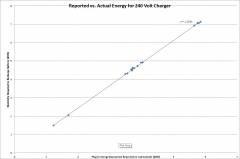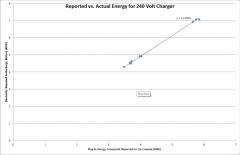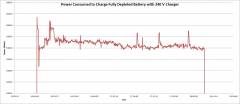

larryh
Fusion Energi Member-
Posts
1,462 -
Joined
-
Last visited
-
Days Won
152
Content Type
Gallery
Profiles
Forums
Everything posted by larryh
-
I think the active grill shutters only close when traveling more the 62 mph to reduce aerodynamic drag (at least for the 2013 model year). Unfortunately, they don't open/close based on engine or outside temperature. A programming change was made for the Fusion Hybrid to make the shutter operation more intelligent based on temperature. I don't know if that has been incorporated into the Fusion Energi yet.
-
The ICE should not start if GO times are used to precondition the car. However, if you remote start the car, I can't guarantee that the ICE won't start. If the high voltage battery is low and the charger cannot keep up with the power required for preconditioning the vehicle, the ICE will most likely turn on. Warning from the manual: To avoid exhaust fumes, do not use remote start if your vehicle is parked indoors or areas that are not well ventilated. The ICE has started on me when the car is plugged in.
-
I believe that the engine block heater is standard on all cars delivered to Minnesota. I'm not sure if the 5 kW heater for the cabin also warms the engine. They could divert the coolant to just the heater core for the cabin. I'm not sure. It would seem to be a waste of energy if it heated the engine too. When I look at the temperature gauge for the engine on the console, it doesn't show the engine temperature to be very warm using just the 5kW heater. Note that the 5 kW heater uses more than 5 kW. There occasionally is a tiny 5+ kW in the upper right corner of the gauge on the console showing the energy used by climate control.
-
Until the temperature fell into the 20's, I had no problem turning on the climate control for heat. The ICE did not start and I was able to make it to work and back entirely in EV mode. Yes, I am also curious to find out what happens when it gets really cold. My car came with an engine block heater. I wonder if that is of significant benefit and will do anything above and beyond the heater core used for climate control.
-
Lately, it has been in the mid 20's here in MN. The cold weather has reduced my EV range from 25 miles to 20 miles, provided I precondition the car using GO times. I set cabin temperature to 72 degrees for preconditioning. When driving, the temperature is set to 63 degrees. I arrive at work with 12 miles of EV range (the distance to work is 8 miles). After letting the car sit for 10 hours in the cold, when I return to the car for my trip home, the EV range has dropped to about 8 miles. The cold definitely takes its toll on EV range and preconditioning results in a significant increase in range. But I have no place to plug the car in at work. For the return trip home, the engine starts up soon after starting the car if the heater for climate control is turned on. It stays on for a couple of minutes. Then I am able to go the rest of the way home in EV mode (just barely). The total amount of plug-in energy consumed, shown on the car's console, is about 5.1 kWh. Normally, it would be about 5.9 kWh for a completely depleted battery. You cannot get as much energy out of the battery when it is cold. The 120 V charger is not very effective in preconditioning the car in the cold. The car uses the energy from the battery to precondition the car. It does not directly use energy from the charger. The charger then tries to restore the energy to the battery used to precondition the car. But the 120 V charger cannot keep up. You will be starting out with a less than full charge after preconditioning the car. The 240 V charger works much better. I have a full charge when starting out after preconditioning the car.
-
I set the temperature to around 63 degrees and use the seat warmers. That allows me about 20 miles of EV range.
-
My electric bill for charging the car last month was $0.99, i.e. less than a dollar. I have a separate meter for the charger. Last month they swapped out my old meter and replaced it with a new smart meter. I just had the original meter installed a couple of months ago. They didn't charge me for the electricity on the old meter that was swapped out. It had 93 kWh on it. They only charged me for the 17 kWh on the new meter. I used 110 kWh of electricity for the month to charge the car at home (I charge at other locations than home too).
-
The maximum amount of power used by either the heater or the AC is 5 kW. To minimize energy usage, set the temperature around 80 or higher for air conditioning and to around 62 or less for heating. The temperature setting has a big impact on the amount of energy used. Yesterday, it was in the mid 20's. I preheated the cabin to 72 degrees before my commute to work (that required about 0.9 kWh of electricity). I turned on the windshield, panel, and floor vents on the MyFord Touch climate screen. It set the temperature to 62 degrees with a low fan and used the seat warmers. For the return trip home, I am unable to plug the car in and precondition the cabin. I was just able to make the 16 mile round trip commute entirely in EV mode. For most of the trip, the power usage for the heater was around 1.25 kW. With AC this past summer, power usage was about half that. Note that cold weather reduces the EV range of the car regardless of climate control. The battery simply cannot provide as much energy in colder weather.
-
Noise cancellation uses the car's sound system. It is always on (even when the audio unit is turned off). You cannot turn active noise cancellation off (other than pulling the fuse).
-

Sony Audio System Fade No Working Properly
larryh replied to larryh's topic in Audio, Navigation & SYNC
What I previously posted is correct. The large 2 rear speakers are the subwoofer speakers. The small speaker behind the vent on the rear shelf is a rear center channel speaker--not a subwoofer. All you have to do is use a SPL meter to test it for yourself. -
I use both Level 1 and Level 2 chargers all the time. I get the same EV range using either one. However, the L2 charger takes about 0.9 kWh less energy to fully charge a depleted battery, and hence, is more efficient in charging the battery.
-
1490 kWh would provide about 5000 EV miles. You would have to be charging a depleted battery about 7 times a day to go that far in EV mode. If you charged the car once a day with a fully depleted battery, that would amount to about 210 kWh / month. A full charge requires about 7 kWh using a 240 V charger. My total electric bill for charging and the house was 750 kWh last month.
-
MyFord Mobile doesn't compute that EV ratio as I would expect. 0% EV miles for a 0 mile trip should not really affect your statistics. However, I think MyFord Mobile simply averages all the EV ratios for each trip the past 30 days and weights them all equally, regardless of how many miles for the trip. So if you have a 10 mile trip with 100% EV miles and a 0 mile trip with 0% EV miles, your score would be (100% + 0%)/2 = 50%. I would have expected it to be (100%*10+0*0%)/10 = 100% After all, all the miles are EV miles. If I look at my past 30 days, 80% of my miles driven are EV miles, i.e. so if I go 1000 miles, 800 of those miles are EV miles. But my ratio score is 95%. My long trips are about 60% EV, but I have many more short trips which are 100% EV. So the way to increase your EV ratio is simply to take a lot of short trips in EV mode.
-

Reported vs. Actual Energy Used for 240 Volt Charger
larryh posted a gallery image in Member's Album
From the album: Car
Reported vs. Actual Energy Used for 240 Volt Charger -

C-Max data in Community info on My Ford Mobile app
larryh replied to howardbc's topic in 2013 Fusion Energi
The C-MAX Energi weighs 3860. The Fusion Energi weighs 3913. There is not much difference. -

C-Max data in Community info on My Ford Mobile app
larryh replied to howardbc's topic in 2013 Fusion Energi
The C-MAX Energi is very similar to the Fusion Energi. They share many common components including the drivetrain. In fact, Ford actually had the EPA test the C-MAX Energi for fuel economy rather than the Fusion Energi and used those results for the EPA ratings of the Fusion Energi on the window sticker. The major difference between the two are the bodies. The Fusion is more aerodynamic than the C-MAX, so it has an advantage for fuel efficiency. If the EPA had actually tested the Fusion Energi, the EPA numbers on the window sticker would probably have been better than what is currently shown own the window sticker. -

Reported Trip Energy Used vs Energy required to recharge car
larryh replied to larryh's topic in Lounge - Fusion Energi
Below is a plot similar to what I did with the 120 Volt Charger. It shows the amount of electricity required to charge the battery with a 240 Volt Charger versus the reported Plug-In energy consumed reported on the car's console. It takes 1.225 times more energy to charge the battery than what is actually extracted from the battery and used to propel the vehicle as reported on the car's console. In other words, only 1/1.225 = 82% of the energy used to charge the car actually propels the vehicle. The remaining 18% of the energy is lost mostly as heat. For the 120 V charger, the numbers are 1.3888 times more energy and 72% efficiency, i.e. significantly less efficient. Over the last couple of months, my true MPGe for trips entirely in EV mode (not what is reported on the car's console) is 124 MPGe based on charging with the 240 V Charger. It is 109 MPGe based on charging with the 120 V charger. Just by using a 240 Volt charger vs a 120 Volt charger, true MPGe increases by 14%. True MPGe is measured using the actual electricity consumed from the wall outlet. -

Reported vs. Actual Energy Used for 240 Volt Charger
larryh posted a gallery image in Member's Album
From the album: Car
Reported vs. Actual Energy Used for 240 Volt Charger -

Reported Trip Energy Used vs Energy required to recharge car
larryh replied to larryh's topic in Lounge - Fusion Energi
Below is a graph showing the power consumed to charge a fully depleted battery. The console indicated 5.8 kWh of energy was used. The actual amount of electricity required to charge the car was 7.071 kWh. It took 2 hours and 9 minutes. So in this case the ratio of kWh consumed at the wall outlet to the plug-in energy consumed reported by the car was 1.22. -

Power Consumed to Charge a Fully Depleted Battery with 240 V Charger
larryh posted a gallery image in Member's Album
From the album: Car
This graph shows the power consumed to charge a fully depleted battery with a 240 V charger. It took 2 hours and 9 minutes and used 7.071 kWh of electricity. -
The EPA actually tested the C-MAX Energi rather than the Fusion Energi when computing the estimates. The C-MAX is less aerodynamic than the Fusion. Thus all the EPA numbers are "conservative" for the Fusion Energi.
-

Reported Trip Energy Used vs Energy required to recharge car
larryh replied to larryh's topic in Lounge - Fusion Energi
After two weeks of charging with the 240 V charger, I have computed the ratio of actual kWh consumed at the wall outlet to the plug-in energy consumed reported on the car's console as 1.23. For the 120 V charger it is 1.39. The 240 V charger is definitely more efficient in charging the battery vs . the 120 V charger. 72% of the wall outlet energy is used to propel the car with the 120 V charger. 81.5% of the wall outlet energy is used to propel the car with the 240 V charger. It takes up to 5.9 * 1.23 = 7.3 kWh to charge a depleted battery with the 240 V charger. It takes up to 5.9 * 1.39 = 8.2 kWh for the 120 V charger. -
Yes, the math is correct based on the EPA estimates. Electricity is expensive in San Diego. At least you get a free charger. It will take over five years to recover the cost for mine. The permit cost me $50.
-

The difference in my home electric bill was....
larryh replied to jeff_h's topic in Batteries & Charging
the manual states that the amplifier should enter standy mode and use less than 0.5 watts of power after 30 minutes without a signal. I had to unplug it to measure the power. Maybe I need to wait for 30 minutes afterwards for it to shut down. The power strip/conditioner itself that I connect all the components to uses 40 watts of power even when I turn its power switch off. That is excessive. My desktop computer is over 10 years old. It was designed for high performance and not energy efficiency. I just assumed that everything would enter standby mode and not use much power when I am not using it. I guess I am going to have to monitor everything in the house and determine how much electricity everything is using. 150 watts of wasted power amounts to $160/year. -

The difference in my home electric bill was....
larryh replied to jeff_h's topic in Batteries & Charging
It now costs me more for electricity for both my computer and for my home theater system just in standby mode alone than it does to commute to work. Something is wrong with this picture. In sleep mode, the computer and home theater system each use about 150 watts. Leaving them plugged in 24 hours a day, that amounts to 3.6 kWh each per day. It takes about 4.2 kWh to charge my car each night for the commute to and from work. The electric rate for the computer and home theater system is about $0.12 / kWh. The electric rate for the charger is $0.0585 / kWh. So it costs about $13 / month for for each the computer and the home theater system. It costs me about $5.40 / month to commute to work. I think it is time to retire my old desktop computer and use a more efficient laptop. The home theater system is going to be turned off. The amplifier is what takes most of the power in standy mode. It doesn't do much good to buy an efficient car to save in energy costs and then squander electricity pointlessly running things that do not need to be powered on.



